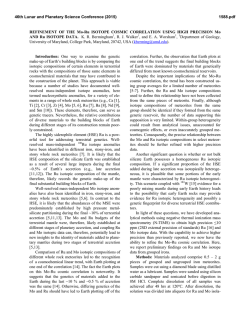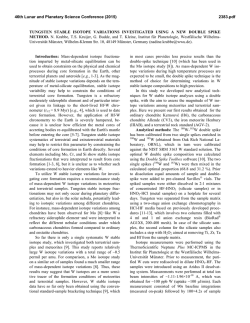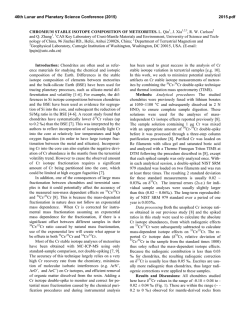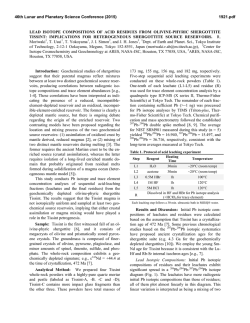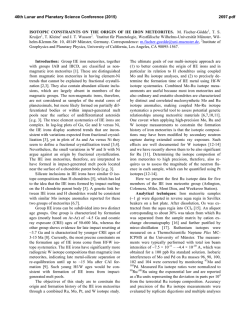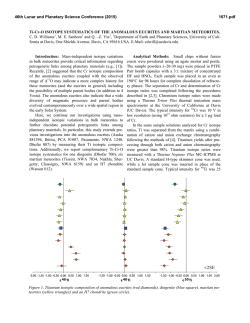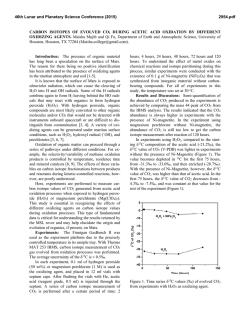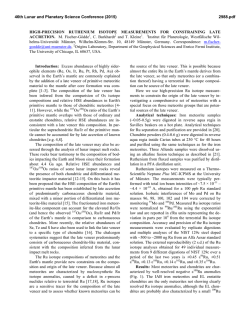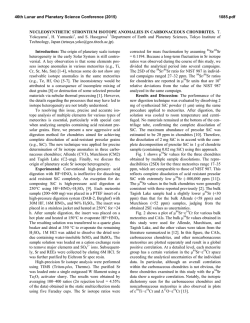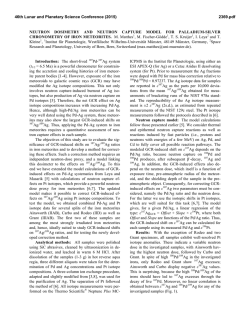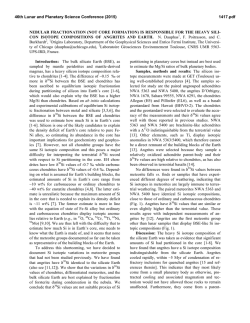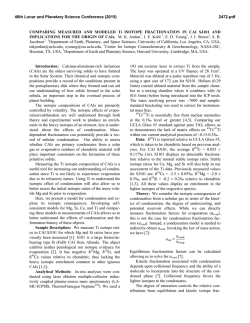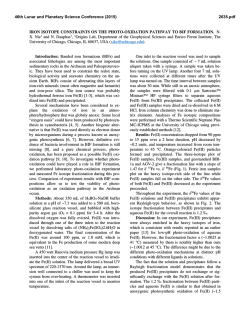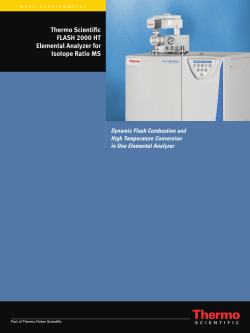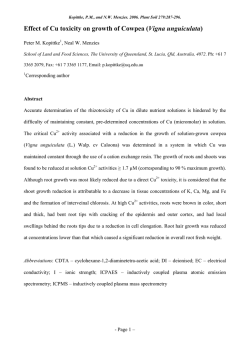
A Procedure to Simultaneously Determine the - USRA
46th Lunar and Planetary Science Conference (2015) 2083.pdf A PROCEDURE TO SIMULTANEOUSLY DETERMINE THE CALCIUM, CHROMIUM, AND TITANIUM ISOTOPIC COMPOSITIONS OF ASTROMATERIALS. M. J. Tappa1,2,3, J. I. Simon1, M. K. Jordan4, and E. D. Young4, 1Center for Isotope Cosmochemistry and Geochronology, ARES division, EISD, NASA Johnson Space Center, Mail Code XI3, Houston, TX, 77058, USA ([email protected]), 2Jacobs, NASA Johnson Space Center, Houston TX 77058, USA, 3Aerodyne Industries - Jacobs JETS contract, NASA Johnson Space Center, Houston, TX 77058, USA, 4Department of Earth, Planetary, and Space Sciences, University of California, Los Angeles, CA 90095, USA. Introduction: Many elements display both linear (mass-dependent) and non-linear (mass-independent) isotope anomalies (relative to a common reservoir), e.g., [1-4]. In early Solar System objects, with the exception of oxygen, mass-dependent isotope anomalies are most commonly thought to result from phase separation processes such as evaporation and condensation, whereas many mass-independent isotope anomalies likely reflect radiogenic ingrowth or incomplete mixing of presolar components in the proto-planetary disk [e.g. 3]. Coupling the isotopic characterization of multiple elements with differing volatilities in single objects may provide information regarding the location, source material, and/or processes involved in the formation of early Solar System solids. Here, we follow up on the work presented in [5], and detail new procedures developed to make high-precision multi-isotope measurements of Ca, Cr, and Ti with small or limited amounts of sample using thermal ionization mass spectrometry and multi-collector ICP-MS, and characterize a suite of chondritic and terrestrial standards. Analytical Procedure: A series of samples were selected to approximately represent the diversity of compositions found in early Solar System objects. Powders of whole-rock samples (BCR-2, Allende) and mineral separates (Labradorite NMNH 115900, Augite NMNH 164905, and Augite NMNH 122142) were dissolved in Teflon beakers containing concentrated HF+HNO3 on a 180°C hotplate for 72 hours. A Hibonite (NMNH R11608) mineral separate was dissolved in a looselycapped precleaned Teflon beaker using HF+HNO3 placed within a Parr digestion vessel and heated to 180°C for 48 hours. Samples were visually inspected to ensure complete dissolution. If undissolved material remained, the dissolution procedure was repeated with new acid. Following dissolution, sample solutions were evaporated and concentrated HNO3 was added. The solutions were then sonicated, fluxed, and evaporated for three repetitions to prevent the precipitation of insoluble fluoride compounds. Chemical separation: The most challenging aspect of this project is designing a technique that effectively separates all of the different elements of interest while maintaining sufficiently high yields to ensure isotope fractionation is not imparted during ion-exchange chromatography. To achieve this we designed a multi-step procedure that exploits the partition coefficients of a number of different ion-exchange resins using multiple elutants. Eichrom TODGA resin is uniquely efficient at separating Ca and Ti from other major elements, which is particularly useful for this study. After samples were successfully digested, evaporated samples are redissolved in 12 N HNO3 and passed through a single-stage column, which effectively separates Ti from all other major elements. The procedure, detailed by [6], uses a 2 mL TODGA cartridge set in a vacuum box and a combination of HNO3+H2O2 to elute Ti. This specific procedure was preferred because it effectively separates Ti from Ca, which is of particular importance due to isobaric interference between 48Ca and 48Ti; and all other elements of interest are eluted in the same step, prior to the elution of Ti. Fe is eluted after Ti, and thus an added benefit of this procedure is that it also separates Cr from Fe, which is important due to the isobaric interference between 54Cr and 54Fe. Following Ti separation, Ca is separated using a second column of TODGA resin with 11 N HNO3 in a vacuum box. This procedure, previously detailed in [5], is documented to be effective for a range of sample compositions. Fresh resin cartridges are always used to avoid the possibility of contamination and the loss of resin efficiency. The majority of cations, including Cr, are eluted together in 2.5 N HNO3 prior to the elution of Ca. The Cr containing cut is evaporated, dissolved in 6 N HCl, and fluxed at 180°C for 12 hours to ensure complete reduction prior to chemical separation. Cr is separated via a two-stage micro column procedure presented in [5]. The 1st stage anion exchange resin (Bio-Rad AG1-X8 200-400 mesh) separates Fe, the 2nd stage cation exchange resin (Bio-Rad AG 50W-X8 200-400 mesh) purifies the Cr. It is possible, though currently inconclusive, that the anion column will no longer be necessary since Fe is efficiently removed from Cr during Ti separation. Isotope Analysis: Chromium and calcium isotope measurements are made using a Thermo Scientific TRITON mass spectrometer housed in the Center for Isotope Cosmochemistry and Geochronology, ARES, 46th Lunar and Planetary Science Conference (2015) NASA-JSC. The specific procedures, including sample loading and analysis methodologies, are detailed in [5]. Briefly, samples are loaded onto outgassed Re filaments and multiple replicates are run for each sample. Both Cr and Ca are analyzed using multi-line analysis methods to better monitor Faraday cup degradation effects over time. Instrument mass fractionation is corrected in-run using an exponential law and data reduction is done offline. For both 53Cr/52Cr and 54Cr/52Cr ratios, the value for a single run is calculated as the cycle average of four magnet settings that utilize different sets of detectors and the sample mean is taken as the average of all of the analyses during a session. For Ca, only data collected during cycles that yield values within an empirically determined range (0.315-0.310) of 42Ca/44Ca are used, as the exponential law does not properly account for instrumental mass fractionation outside of this range. For 40 Ca/44Ca and 43Ca/44Ca, we perform a multidynamic analysis utilizing different sets of detectors, which we report for each run. All ratios are presented in epsilon notation (ε) which is calculated as the deviation from session-averaged standard value in parts per 10,000. For each sample, we report the weighted mean of n replicates for each ratio, and 2σ uncertainty on the weighted mean. The analysis method for Ti by MC-ICPMS at UCLA has been developed for standard solutions and tests utilizing purified materials are in progress. Results: Some Cr and Ca data has been presented previously [5] using a preliminary version of the method outlined above. Calibrated elution curves (e.g., for Ca in Fig. 1) for each chemical separation step indicate that the current ion-chromatography is effective at quantitatively separating the target elements. Ca isotopic results: Recent comprehensive studies of oceanic basalts and peridotites [2,7] indicate an observable excess of ~0.7ε between the ε40Ca value of the standard (SRM 915a) and that of Earth’s mantle, therefore we reference our samples to this mantle value [2,7]. Nearly all measured Ca ratios yield mantle values, and the data for Allende and BCR-2 agree with previously reported values for those samples [2]. Calcium separated from the terrestrial Hibonite R11608 has a positive ε40Ca value. The information required to apply a correction for radiogenic ingrowth are not available, so it is unclear whether this represents radiogenic excess from the decay of 40K or a different and possible massdependent process, which could further be evaluated using a double-spike method [i.e. 8]. 2083.pdf Figure 1: Relative elution curves for 17 elements during Ca separation using 2mL TODGA resin cartridges. Cr is collected and further purified. Figure 2: Ca isotope data measured at JSC (solid symbols) and comparative literature values (open symbols). Gray box represents 2SD of the long-term average of SRM 915a. Square symbols are corrected for radiogenic ingrowth with data from [2]. References: [1] Russell W. A. et al. (1978) GCA, 42, 1075. [2] Simon J. I. et al. (2009) Astrophys. J., 702, 707-715. [3] Trinquier A. et al. (2009) Science, 324, 374-376. [4] Qin L. et al. (2010) GCA, 74, 1122-1145. [5] Tappa, M.J. et al. (2014) LPSC 45, #1908. [6] Zhang, J. et al. (2011) JAAS, 26, 2197-2205. [7] Mills R. D. et al. (2014) in prep. [8] Simon J. I. and Depaolo D.J. (2010) EPSL, 289, 457-466.
© Copyright 2026
